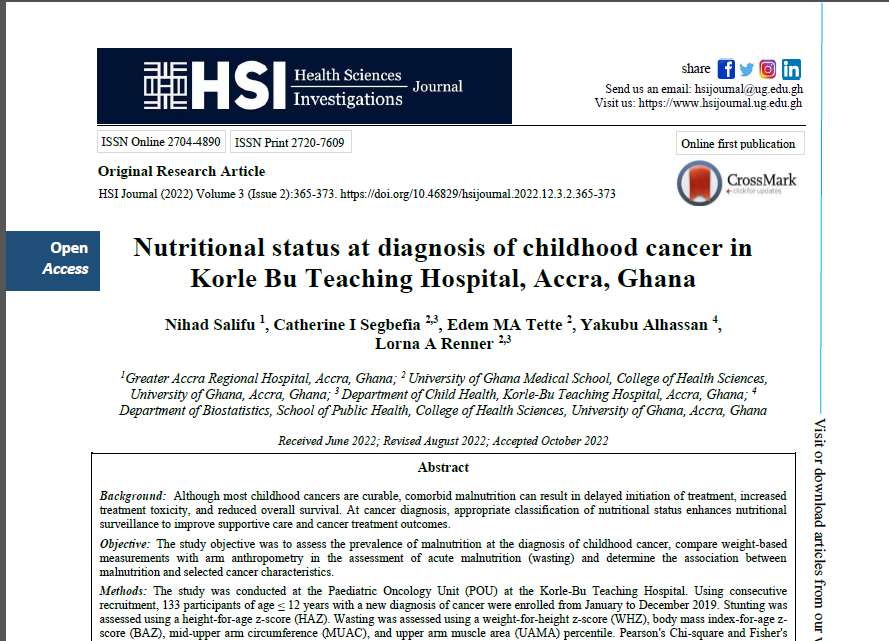Nutritional status at diagnosis of childhood cancer in Korle Bu Teaching Hospital, Accra, Ghana
Nutritional status of children with childhood cancer
Abstract
Background: Although most childhood cancers are curable, comorbid malnutrition can result in delayed initiation of treatment, increased treatment toxicity, and reduced overall survival. At cancer diagnosis, appropriate classification of nutritional status enhances nutritional surveillance to improve supportive care and cancer treatment outcomes.
Objective: The study objective was to assess the prevalence of malnutrition at the diagnosis of childhood cancer, compare weight-based measurements with arm anthropometry in the assessment of acute malnutrition (wasting) and determine the association between malnutrition and selected cancer characteristics.
Methods: The study was conducted at the Paediatric Oncology Unit (POU) at the Korle-Bu Teaching Hospital. Using consecutive recruitment, 133 participants of age ≤ 12 years with a new diagnosis of cancer were enrolled from January to December 2019. Stunting was assessed using a height-for-age z-score (HAZ). Wasting was assessed using a weight-for-height z-score (WHZ), body mass index-for-age z-score (BAZ), mid-upper arm circumference (MUAC), and upper arm muscle area (UAMA) percentile. Pearson's Chi-square and Fisher's exact tests were used to determine the association between nutritional status, cancer type and risk group.
Results: The median age of participants was 4.5 years, and 64.7% ( n = 86/133) were male. Of the 133 participants, 60.9% ( n = 81) were diagnosed with solid tumours, 23.3% (n = 31) with leukaemia, and 15.8% (n = 21) with lymphoma. At cancer diagnosis, the prevalence of stunting was 16.8% (n = 22/131) while the prevalence of wasting was 21.8% (n = 29/133 ) and 40.5% (n = 53/131 ) using weight-based measurements (WHZ or BAZ) and arm anthropometry (MUAC or UAMA), respectively. No participant was obese. Lymphomas were significantly associated with wasting (p = 0.022). Participants with high-risk cancers were more likely to be stunted and wasted.
Conclusion: Mid-upper arm circumference and UAMA detected more children with wasting than WHZ and BAZ at cancer diagnosis. Advanced-stage disease and lymphoma were associated with wasting. Establishing a nutritional rehabilitation programme at the POU, KBTH would ensure early and appropriate nutritional interventions to correct or prevent further nutritional deficits.


